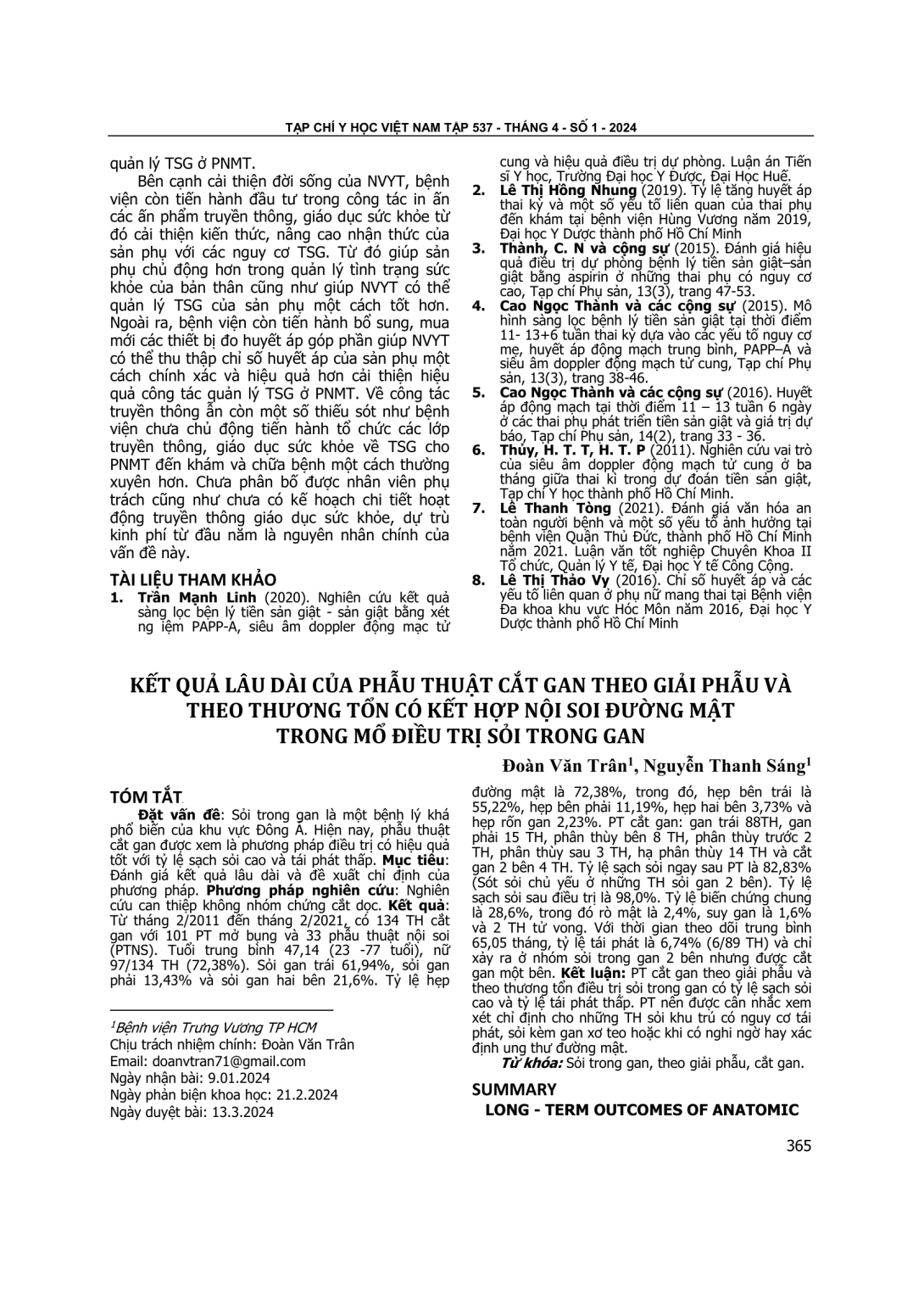
Đánh giá kết quả lâu dài và đề xuất chỉ định của phương pháp. Phương pháp nghiên cứu: Nghiên cứu can thiệp không nhóm chứng cắt dọc. Kết quả: Từ tháng 2/2011 đến tháng 2/2021, có 134 TH cắt gan với 101 PT mở bụng và 33 phẫu thuật nội soi (PTNS). Tuổi trung bình 47,14 (23 -77 tuổi), nữ 97/134 TH (72,38%). Sỏi gan trái 61,94%, sỏi gan phải 13,43% và sỏi gan hai bên 21,6%. Tỷ lệ hẹp đường mật là 72,38%, trong đó, hẹp bên trái là 55,22%, hẹp bên phải 11,19%, hẹp hai bên 3,73% và hẹp rốn gan 2,23%. PT cắt gan: gan trái 88TH, gan phải 15 TH, phân thùy bên 8 TH, phân thùy trước 2 TH, phân thùy sau 3 TH, hạ phân thùy 14 TH và cắt gan 2 bên 4 TH. Tỷ lệ sạch sỏi ngay sau PT là 82,83% (Sót sỏi chủ yếu ở những TH sỏi gan 2 bên). Tỷ lệ sạch sỏi sau điều trị là 98,0%. Tỷ lệ biến chứng chung là 28,6%, trong đó rò mật là 2,4%, suy gan là 1,6% và 2 TH tử vong. Với thời gian theo dõi trung bình 65,05 tháng, tỷ lệ tái phát là 6,74% (6/89 TH) và chỉ xảy ra ở nhóm sỏi trong gan 2 bên nhưng được cắt gan một bên. Kết luận: PT cắt gan theo giải phẫu và theo thương tổn điều trị sỏi trong gan có tỷ lệ sạch sỏi cao và tỷ lệ tái phát thấp. PT nên được cân nhắc xem xét chỉ định cho những TH sỏi khu trú có nguy cơ tái phát, sỏi kèm gan xơ teo hoặc khi có nghi ngờ hay xác định ung thư đường mật.
To evaluate the long-term results and to propose the indications of this surgical method. Method: Noncontrolled longitudinal interventional study. Results: From 2/2011 to 2/2021, 134 hepatectomies were performed by laparoscopic (33 cases) and open surgery (101 cases). The mean age was 47.14 (23 -77), 72,38% was female. Hepatolithiasis appeared in the left lobe 61,94%, right lobe: 13,43% and bilateral: 21,6%. 72,38% had bile duct strictures with 57,22% on the left side, 11.19% on the right side and 3,73% bilateral and 2.23% at the hilum. We realized 88 left hepatectomies, 15 right hepatectomies, 8 left lobectomies, 2 anterior sectionectomies, 3 posterior sectionectomies, 14 segmentectomies, and 4 bilateral hepatectomies. The immediate postoperative stone clearance rate was 82,83% (Retained stones occurred mostly in bilateral hepatolithiasis). The final stone clearance rate was 98%. The overall complications were 28.6% including: bile leakage 2.4%, liver failure 1.6% and 2 deaths. With a mean follow-up of 65,05 months, recurrent stones developed in 6,74% (6/89 patients) exclusively for bilateral hepatolithiasis. Conclusion: Anatomic liver and biliary lesion resection for intrahepatic stones is an effective treatment for hepatolithiasis, with a high stone clearance and a low stone recurrence rate. Indication of hepatectomy should be carefully considered for high recurrence risk regional hepatolithiasis or for intrahepatic stones associated with liver atrophy or bile-duct lesions.
- Đăng nhập để gửi ý kiến
